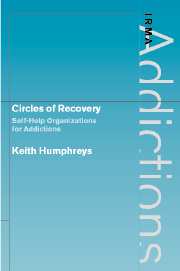Book contents
- Frontmatter
- Contents
- Acknowledgements
- 1 Definitions, scope, and origin of the health-related self-help group movement
- 2 An international tour of addiction-related mutual-help organizations
- 3 Does self-help group participation lead to positive addiction-related, psychiatric, and medical outcomes?
- 4 A different perspective on change in self-help organizations: spirituality, identity, life stories, friendship networks, and politicization
- 5 How should government agencies, healthcare organization, and clinicians interact with self-help organizations?
- Epilogue: summing up, moving forward
- References
- Index
5 - How should government agencies, healthcare organization, and clinicians interact with self-help organizations?
Published online by Cambridge University Press: 31 July 2009
- Frontmatter
- Contents
- Acknowledgements
- 1 Definitions, scope, and origin of the health-related self-help group movement
- 2 An international tour of addiction-related mutual-help organizations
- 3 Does self-help group participation lead to positive addiction-related, psychiatric, and medical outcomes?
- 4 A different perspective on change in self-help organizations: spirituality, identity, life stories, friendship networks, and politicization
- 5 How should government agencies, healthcare organization, and clinicians interact with self-help organizations?
- Epilogue: summing up, moving forward
- References
- Index
Summary
External support of self-help organizations: benefits and risks
This chapter discusses different types of interactions between self-help organizations and government agencies, healthcare organizations, and individual clinicians. A sizable literature addresses how some techniques, ideas, and language from self-help groups can be combined with professional treatment interventions, for example writings on “recovery sensitive counseling” (Morgan, 1995), “social model” recovery programs (Borkman, Kaskutas, & Barrows, 1996), and therapeutic communities (De Leon, 1999). The present chapter complements such works by focusing instead on how supportive outsiders should interact with self-help organizations in cases where each party is autonomous and maintains its own sphere of operation.
Individual citizens of democratic societies do not need any complex rationale for attending self-help groups any more than they need one to go bowling. They wish to engage in a voluntary activity, and so they do so. In contrast, outside entities from the other sectors of society, for example public health departments, hospitals, and government agencies, are usually chary of intervening in the voluntary sector. In all free societies, citizens expect some compelling rationale before accepting extensive outside intervention into civil society (e.g., their marriages, families, religious organizations, and voluntary activities). What could justify anything other than a laissez faire policy toward self-help organizations? Two rationales come easily to mind: (1) direct health benefits and (2) healthcare cost reductions.
Direct health benefits
Chapter 3 concluded that self-help group participation can reduce substance use, psychopathology, and attendant social suffering and disorder.
- Type
- Chapter
- Information
- Circles of RecoverySelf-Help Organizations for Addictions, pp. 149 - 176Publisher: Cambridge University PressPrint publication year: 2003

